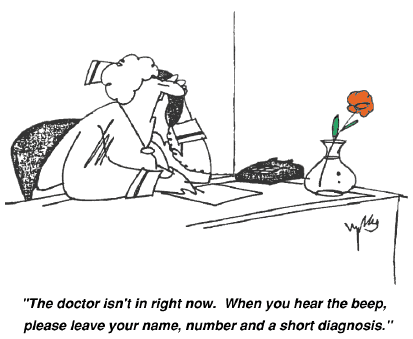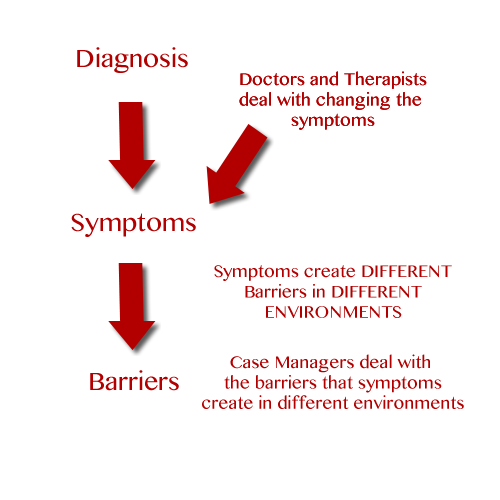Lesson 3: Alternative Models
Attention

Learning Outcomes
Upon completion of this lesson's material, students will be able to:
- Describe the disease model approach to Mental Illness
- Distinguish between the presence of the "disease" and the presence of the "disability"
- Identify the major barriers that persons with Mental Illness may face
- Describe the role that PSR plays in the course of treatment for persons with Mental Illness
Teaching
Genetic Factors and Mental Illness
When we look at the etiology of mental illness being connected to brain structure and neurochemical imbalances we have to explore the concept that these may be inherited.
We examine the genetic role in mental illness by studying twins (same as we study many of the questions of genetic and environmental factors in human development and behavior).
The Experience of Mental Illness
Symptoms and Etiology of Mental Illness
Diagnoses and Psychosocial Rehabilitation
Through this content you have been exposed a bit to the medical side of Mental Illness...the establishment of diagnoses to correctly identify the symptomatology and some aspects of the course of treatment (medications, counseling, etc.)
But what has all this to do with PsyR?
PsyR serves to assist people WITH MENTAL ILLNESS in developing the skills and resources necessary to LIVE in the ENVIRONMENT of their choice.
PsyR techniques serve to assist individuals in living WITH the symptoms of their illness just as a person may learn to live with blindness or a hearing impairment. We don't necessarily CURE the illness or even treat the illness itself. PsyR focuses on the barriers that exist within someone's life because they have a mental illness (symptoms) in order to maximize their independence.
So, in a way, the BARRIERS are more important than the DIAGNOSES. We still need to know about diagnosing because it helps us understand what folks are going through...but our focus is on the barriers these symptoms create.
Stress and Mental Illness
Much has been made regarding the impact of stress upon the etiology of mental illness/disorders. The most commonly cited etiological explanation for mental disorders is the Diathesis-Stress Theory.This assumes that an individual who was already predisposed biologically to develop mental illness may do so under stressful conditions. The impact of the stressor upon neurochemistry is thought to be one of the major causal factors in many psychological disorders.Of course, this is just one piece of the puzzle. Current models of etiology explore the interaction of multiple factors in determining the cause of mental disorders. These are termed, "integrative" models.
Stigma and Mental Illness
- Labels of mental illness can evoke feelings of fear and rejection in others
- Symptoms are not often attributable to causes
- Person First Language
- A person with Schizophrenia, not a Schizophrenic
- A person with Depression, not a Depressive
- Societal expectations of behavior are flexible…to a point…
-
- What is the breaking point where we identify someone as deviant or abnormal?
- Work
- Dress
- Personal Hygiene
- Language
- We lack a clear, well-known etiology for mental illness so people fear it
Psychiatric Disability
- What makes a person “disabled”?
- Mental Illness often strikes in the late teens and early twenties. What is NORMALLY going on during this time? THIS is what gets disrupted.
-
- Intellectual development
- Social development
- Vocational development
- Issues of identity formation
- Degree of disability might depend on their “Premorbid” level of functioning.
- “Disability” is a LEGAL term as well. It connects individuals to a system of support and social expectation
Psychiatric Rehabilitation
Rehabilitation refers to the process of returning someone to a former state of constructive activity, or function.
What do you think of the following two definitions:
- The goal of psychiatric rehabilitation is to enable individuals to compensate for, or eliminate the functional deficits, interpersonal barriers, and environmental barriers created by the disability, and to restore ability for independent living, socialization, and effective life management.
- Psychosocial Rehabilitation means that a person who before was afraid to go into a store to order an ice cream soda can now be an ice cream store manager.
PsyR and Treatment
Even though we have been talking about the medical aspects of mental illness...we still see a role for the application of PsyR activities.
For any given individual the constellation of treatment may include medications, housing, group work, vocational work, therapy, and exercise. Each aspect of the treatment plan contributes to the outcomes that the person may experience. This is highly individualized work.
Since PsyR practices focus on the BARRIERS that individuals experience due to their symptomatology, it is often very effective at addressing the pragmatic, every-day issues that come up in a person's life. Every-day issues, when combined with mental illness can be devastating.
In addition, because of the course of many of the mental illnesses, individuals with diagnoses are often lacking specific social experience and social skills that many of us take for granted. Skill training on how to negotiate in the wider social world is some of the most important work we do.
Consider these Examples

As Case Managers we approach helping by doing the following:
- Try to understand and document how the symptoms a person is experiencing is creating a barrier for them to perform in a specific environment.
- This barrier depends more on the environment than on the actual symptoms.
- Creatively come up with solutions as to how the person can perform in that environment even though they have the symptoms.
Consider these environments:
- School
- Work
- Church
- Relationships
- Grocery Store
- Movie Theater
- Social Club
Depending on the person's symptoms they may experience DIFFERENT barriers in these DIFFERENT environments.
Example 1: Diagnosis Anxiety Disorder, Symptom Aggitated movement and difficulty sitting still.
- This particular diagnosis/symptom may not produce any barriers for the person to perform in the Grocery Store or at the Social Club
- It may produce a barrier at the Church and the Movie Theater
- Your job would be to find creative ways for this person to attend church and/or go to the theater...
- Possible Solutions:
- Watch the church service on TV and have rituals performed at home.
- Stand in the back of the church with permission to move about in the back and minimize disruption
- Watch movies at home
- Attend movies during the times when there is not a lot of people, sit at the back, and allow them to roam about during the movie
Example 2: Diagnosis Depression, Symptom Difficulty sleeping and has trouble getting up in the morning.
- This particular diagnosis/symptom may not produce any barriers for the person to perform in Relationships or at the Movie Theater
- It may produce a barrier at the Work and School.
- Your job would be to find creative ways for this person to work and/or go to school
- Possible Solutions:
- Online classes
- Afternoon classes only...no morning classes
- Buddy system to make it to class on time
- Home based work opportunities
- Alternative schedules of work
PLEASE NOTE: None of my interventions involve doing anything to actual reduce the SYMPTOMS!
We assume those are there and we try to work around them...THAT is Psychosocial Rehabilitation!
Assessment
Class Discussion
Describe the difference between treating symptoms (clinical applications) and treating the environment (removing barriers).
Lesson 3 Quiz
- Utilizing the PsyWeb website, select one of the mental illnesses listed on the left of the page and summarize the symptoms.
- Referring to your answer in question 1, which factors may become important to you in your role as a Psychosocial Rehabilitation Practitioner? (Remember we look at how SYMPTOMS create BARRIERS to FUNCTIONING in a specific ENVIRONMENT) Provide a detailed description of ONE symptom and how that symptom may produce a real barrier in the world for that person.
- Provide a brief treatment plan idea that you think would be effective in removing or dealing with the barrier that you identified. (Remember, the treatment needs to remove the BARRIER not the SYMPTOM...we are assuming the symptom will stay)
An example of the answer for #2 and #3 might be as follows:
#2 - One of the symptoms of Major Depression includes problems with concentration, thinking, or decision making. This would be a barrier to functioning at home because my client would have difficulty concentrating on the chores he or she would have to complete each week.
#3 - My intervention would be to create a schedule of chores that hangs on the refrigerator. I would be sure that the chores could be done in a short period of time and that not too many chores are required each day.